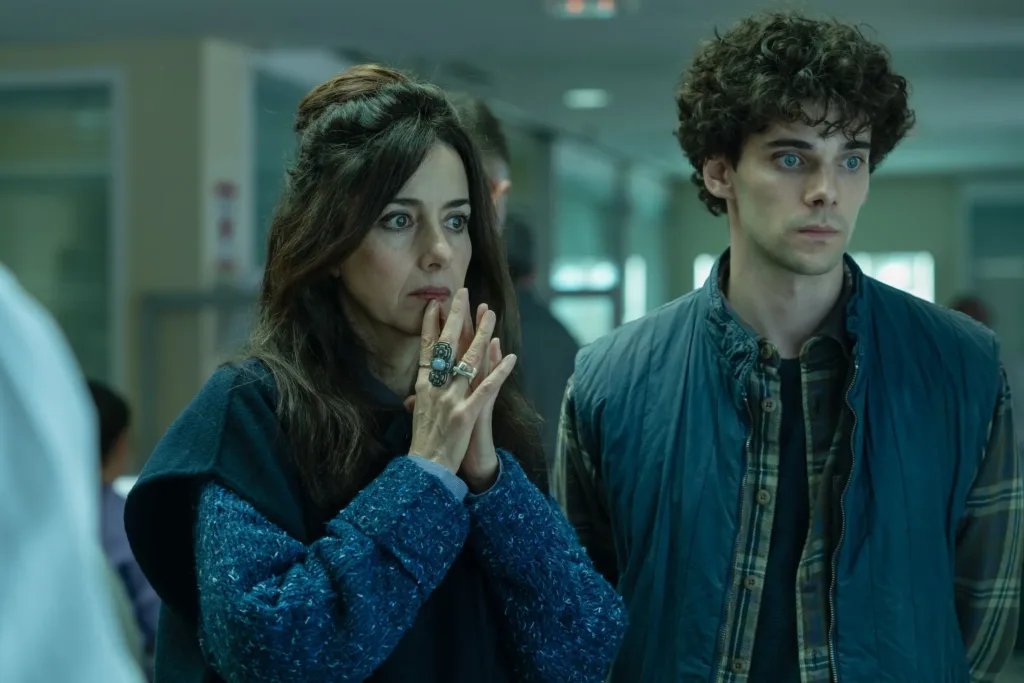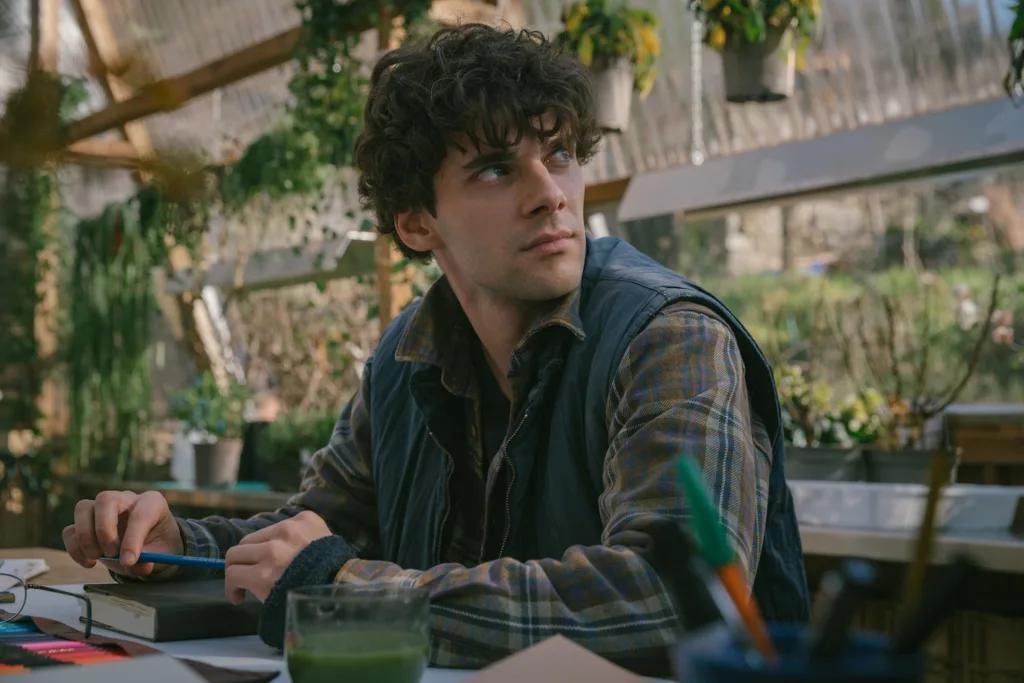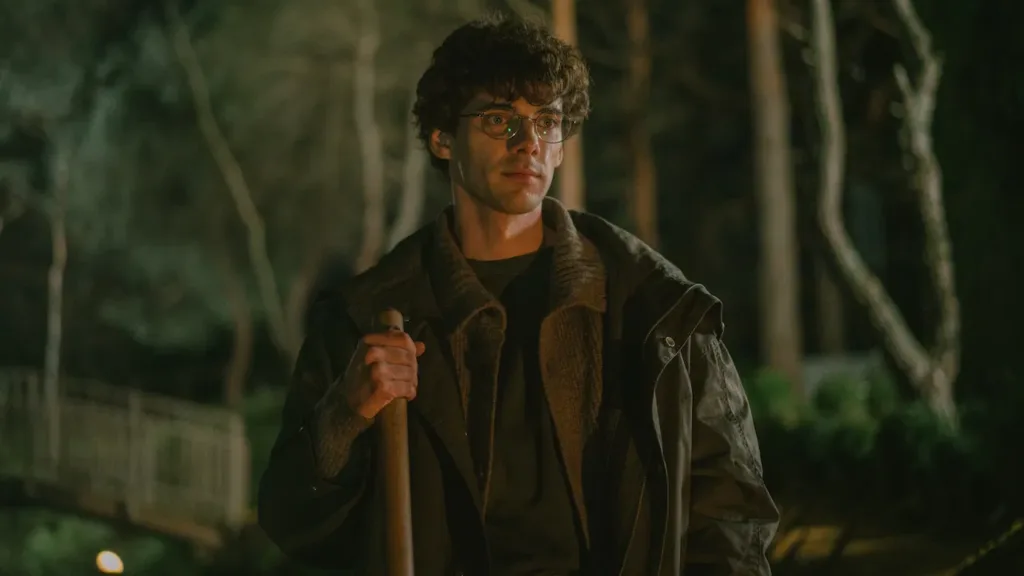In a country where passion and peril collide, The Gardener unfolds as a Spanish romantic thriller with an unconventional narrative. Set against the backdrop of a modest town where a local nursery conceals a secret existence in contract killing, the series introduces Elmer—a young assassin marked by a painful past—and his controlling mother, La China Jurado. Elmer’s calculated life in horticulture masks a chilling vocation, his clinical nature disrupted only when a forbidden attraction emerges.
The setting operates as both sanctuary and stage, where the beauty of nature clashes with the grim reality of a life taken in the shadows. Subtle humor weaves through moments of dark intensity, rendering the atmosphere rich and thought-provoking.
Within this environment, tensions arise as Elmer’s long-dormant capacity for emotion begins to fracture under the weight of love and ethical conflict. The narrative teases the viewer with hints of a transformation; the hitman whose heart was once locked in an unyielding frost now stands at the precipice of an uncharted emotional terrain.
Shifting Motifs in a Dark Duality
The series initiates with a stark introduction: a young man stripped of emotional fabric by an early, violent encounter with fate stands on the knife’s edge between brutality and tenderness. The inaugural moments unfurl like a cinematic riddle—every frame murmurs secrets, casting long shadows over a life that should blossom beneath a sunlit sky. The immediate tension, a collision of cold calculation and dormant passion, sets forth a narrative that oscillates between eerie calm and simmering unrest.
Elmer navigates a double existence that is methodically portrayed—by day, he tends to a flourishing gardening enterprise; by night, his steps echo in corridors of clandestine retribution. His engagement in contract killing operates as a stark counterpoint to the serene facades of horticulture, establishing a dichotomy that is as captivating as it is unsettling.
The ill-fated directive to erase Violeta, intended as a mere transactional maneuver, triggers an unforeseen metamorphosis in his character. The plot incorporates a sequence where a spark of tenderness challenges the ice of detachment, provoking an evolution that reverberates throughout his secret life.
Strategically placed plot twists punctuate the storyline: subtle revelations emerge like elusive brushstrokes revealing a portrait of a man at war with his own design. The peripheral narratives featuring discreet investigations by local enforcers quietly amplify the overarching tension.
These narrative choices enrich the texture of the series, imprinting each scene with a refined interplay of suspense and amorous conflict. As the seeds of transformation germinate amid calculated violence, each unfolding moment crafts an intricate tableau where crime, affection, and existential questioning coalesce with a measured cadence that impresses with its deliberate precision.
Contrasting Figures in a Calculated World
Elmer appears as a figure molded by a harsh fate. A man marred by a violent incident in his early years, he now operates as a hitman who conducts himself with methodical coldness. His progression is marked by quiet moments when an unexpected sensitivity shows its first signs.
His daily involvement in a gardening business exists alongside a hidden career in contract killing—a study in duality where professional detachment collides with the stirrings of newfound emotion. His evolution hints at an inner struggle over a life dictated by circumstance and shaped by a past that refuses to release its grip.
La China Jurado stands as a formidable presence whose ambitions and manipulations shape not just her own destiny but that of her son as well. Her relentless quest for financial security and social recognition is revealed through a voice that carries both authority and calculated warmth. She maintains a strict hold over Elmer, using familial ties as instruments of control. Through her measured narrative, a portrait emerges of a woman whose personal agenda feeds directly into the operations of their dual enterprise.
Violeta enters as an unexpected influence, her very existence challenging the established order. Her role transcends a mere assignment, as the repercussions of her interaction with Elmer trigger changes that disrupt a carefully ordered life. Her presence introduces layers to the narrative that leave aspects of her character open to interpretation, generating subtle ripples through the otherwise systematic progression of events.
Even supporting characters contribute their own accents to this multifaceted portrayal. The local investigators, Torres and Carrera, provide brief yet meaningful diversions that intermittently contrast with the heavier tones of the main storyline.
Their interactions inject moments of levity and serve to broaden the narrative frame through a series of understated exchanges. Every actor’s portrayal is crafted with attention to nuance, their expressions and timing supplying a measure of quiet precision that animates the textural complexity of the narrative.
Seeds of Transformation: The Language of Emotion and Control
The narrative examines a state of emotional isolation that serves as both a character trait and a visual motif. A traumatic event renders the central figure unable to feel, a condition that mirrors a barren landscape waiting for the touch of renewal. The spark of affection acts as a transformative force, coaxing life into an otherwise dormant emotional world. This awakening suggests that moments of tenderness can disrupt even the most calculated existence.
The connection between Elmer and his mother is portrayed as a force bound by duty and ambition. Their relationship unfolds as an intricate power play where personal interests and familial ties collide. The dynamic oscillates between dependency and domination, revealing a partnership that is as confining as it is driven by an unyielding pursuit of financial stability. The mother’s influence secures control over her son, even as the narrative hints at a latent desire for individual liberation.
A striking interplay emerges between the domains of horticulture and organized retribution. The garden serves as a striking visual metaphor, its cycles of growth and decay reflecting the inherent duality of human nature.
Lush blooms and the inevitable withering of petals speak to both nurturing care and the cold mechanics of execution. Within this setting, the cycle of creation and destruction is etched into every scene, provoking a contemplation of beauty intertwined with violence.
Moral dilemmas surface as the storyline questions established notions of duty and desire. In this space, the act of killing coexists with the budding possibility of redemption—a provocative framework that challenges the viewer to reconsider definitions of ethics and connection.
Frames of Conflict and Care
The series presents a visual realm where shadows and lights mingle in a dialogue of contrast. The cinematography is both deliberate and daring, pairing dark, almost oppressive lighting with the unexpected vitality of a garden in full bloom.
Tight, purposeful framing creates an air of suspended tension, while fluid camera movements reveal hidden layers of meaning in every carefully composed shot. Each scene becomes an intricate study in visual storytelling, where even a simple glance across a greenhouse evokes an unsettling mix of hope and foreboding.
The director’s vision materializes through an innovative interplay of narrative devices. The use of voiceovers delivered by La China Jurado infuses the story with a distinctive cadence, offering intimate glimpses into the inner workings of characters without ever betraying the cool detachment that defines their lives. This technique, paired with an unflinching portrayal of everyday violence, strikes a fine balance between theatrical flair and a stubborn insistence on realism.
Every set piece contributes to a larger tapestry of dual meaning. The gardening center, for instance, functions simultaneously as a haven of life and a cynical façade for criminal endeavors. Locations are chosen with an artistry that speaks to the show’s inherent contradictions.
The score and sound design are equally precise—subtle strains build tension in quiet corridors, while more pronounced audio cues mark shifts in mood, further deepening the narrative’s layered texture. A measured, haunting voice carries the weight of many unsaid truths, lending the production an additional, resonant undertone.
Spoken Shadows and Silent Shifts
A singular narrative perspective, voiced through La China Jurado, provides a resolute anchor within an unfolding story that might otherwise scatter into disjointed narratives. Her measured commentary interlaces personal reflections with unsparing observations, enriching the audience’s grasp of character intentions while maintaining an impersonal firmness in tone. The narration, marked by its precise articulation of inner thoughts, serves as a conduit for understanding the motives behind calculated actions.
The composition of the narrative is structured to accommodate a multiplicity of plot streams—a professional pursuit veiled in horticultural business, an encounter evolving into a romance, and the meticulous procedures of a police investigation—each meeting deliberate timing in the development of their arcs. This careful dispersion of storylines, layered with methodical reveals, sustains a coherent progression that allows each thread to resonate without overpowering the others.
Timing emerges as a fundamental element in building tension, where moments of stark violence are interspersed with reflective pauses that invite the viewer to scrutinize the emotional resonances at play. Flashbacks intertwine with present events, reshaping the viewer’s understanding of past wounds and nascent desires.
This measured cadence not only sharpens suspense but also foregrounds the transformation in Elmer, whose journey from remnant stoicism to burgeoning awareness is hinted at through meticulously crafted sequences. The interplay between deliberate action and reflective hesitation forms a rhythm that compels attention and grants the narrative a presence that reverberates quietly, yet unmistakably, throughout.
Heartstrings in Shadowed Light
The series cultivates viewer empathy for figures burdened by personal flaws and unspoken scars. A mosaic of intimate backstories and moral dilemmas reflects the complexities of human connection, while moments of subtle humor and irony soften stark scenes.
Elmer’s transformation—once a figure of emptiness gradually touched by unforeseen warmth—unfolds with a calm precision that sparks renewed interest in every episode. His evolution is portrayed through carefully measured scenes where dramatic tension intermingles with glimpses of tenderness.
Unexpected twists, carefully placed cliffhangers, and a slow buildup of character relationships sustain a steady engagement, encouraging a continuous investment in each unfolding moment. The series maintains a deliberate rhythm through pauses and shifts in intensity that illuminate fragile bonds and shifting alliances.
Every gesture, each poignant exchange, intensifies the viewer’s connection with a narrative that balances electrifying suspense with quiet, reflective intervals. This strategic interplay of high stakes and gentle introspection enlivens the screen, drawing the audience into a world where even the subtlest expression opens a window into the complexities of a life teetering between cold calculation and stirring emotion.
Full Credits
Writers: Miguel Sáez Carral
Producers and Executive Producers: Raquel Badají
Cast: Cecilia Suárez, Álvaro Rico, Ivan Massagué, Catalina Sopelana, Emma Suárez, Javier Morgade, María Vázquez, Francis Lorenzo, Isabel Garrido, Esteban Roel, Candela Solé
Director of Photography (Cinematographer): Rafa García
Editors: Regino Hernández, Domi Parra, Joe Tornos
Composer: Lucas Vidal
The Review
The Gardener
The Gardener stuns with an unpredictable narrative that unites a stark portrayal of emotional dormancy and a surge of unsought warmth. Its deliberate pace, intricate character dynamics, and arresting visual compositions demand careful attention, inviting a reconsideration of familiar moral frameworks. Each meticulously set scene—a convergence of domestic tension and covert, lethal intent—elicits a potent blend of restraint and surprise.
PROS
- Engaging narrative complexity
- Memorable performances that lend conviction to every scene
- Visually striking, blending moody lighting with lush imagery
- Deliberate pacing that cultivates a palpable sense of suspense
- Rich, layered storytelling that accentuates character evolution
CONS
- Pacing may seem uneven to some viewers
- Certain character motivations occasionally lack full exploration
- Tonal shifts might challenge conventional thriller expectations





















































